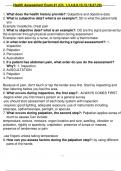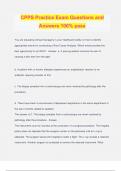Health Assessment Exam #1 (Ch. 1,3,4,8,9,10,12,18,27,29)
1. What does the health history provide?: Subjective and objective data
2. What is subjective data? what is an example?: SD is what the patient tells
you
Example: headache, chest pain
3. What is objective data? what is an example?: OD are the signs perceived by
the examiner through physical examination during assessment
Example: rash seen by a nurse, or temp taken with a thermometer
4. In what order are skills performed during a typical assessment?: 1.
Inspection
2. Palpation
3. Percussion
4. Auscultation
5. If a patient has abdomen pain, what order do you do the assessment?
Why?: 1. Inspection
2. AUSCULTATION
3. Palpation
4. Percussion
Because of pain, don't touch or tap the tender area first. Start by inspecting and
then listening before you feel the area.
6. What occurs during inspection, the first step?: -ALWAYS COMES FIRST
-begins when you first meet a person w/ a general survey
-you should start assessment of each body system with inspection
-requires: good lighting, adequate exposure, use of instruments including
otoscope, opthalmoscope, penlight, or specula
7. What occurs during palpation, the second step?: Palpation applies sense of
touch to assess Can include:
temperature, texture, moisture, organ location and size, swelling, vibration or
pulsation, rigidity or spasticity, crepitation, presence of lumps or masses,
presence of tenderness or pain
-use fingers unless taking temperature
8. How can you assess factors during the palpation step?: by using different
parts of the hands
,9. During palpation, what should fingertips be used to feel?: -best for fine
tactile discrimination of skin texture, swelling, pulsation, and determining
presence of lumps
10. During palpation, what should fingers and thumb be used for?: -
detection of position, shape, and consistency of an organ or mass
11. During palpation, what should the dorsa of hands and fingers be used
for?: -best for determining temperature because skin here is thinner than on
palms
12. During palpation, what should the base of fingers or the ulnar surface of
hand be used for?: -best for vibration
**-vibrations are felt on the ulnar side of hand
13. During palpation, what type of palpation should you start with and why?
What steps are next?: 1. start with LIGHT palpation to detect surface
characteristics and accustom person to being touched
-1 cm
2. then deeper palpations when needed
-intermittent pressure better than one long continuous palpation -
5 to 8 cm or 2-3 in
ALSO: bimanual palpation- requires use of both hands to envelop or capture certain
body parts or organs such as kidneys, uterus or adnexa for precise delimitation
14. What occurs during percussion, the third step?: -consists of tapping a
person's skin with short, sharp strokes to assess underlying structures
15. What uses does percussion have?: -mapping location and size of organs
-signaling density of a structure by a characteristic note
-detecting a superficial abnormal mass
1. percussion vibrations penetrate about 5 cm deep
2. deeper mass would give no change in percussion
-eliciting pain if underlying structure is inflamed
-eliciting deep tendon reflex using percussion hammer
16. HOLLOW (AIR-FILLED) ORGANS SOUND DIFFERENT THAN SOLID
ORGANS:
17. What are the two methods of percussion?: 1. Direct, or immediate, which
is when the striking hand directly contacts body wall
, .
2. Indirect, or mediate, is when you use both hands and the striking hand contacts
stationary hand fixed on person's skin
18. In regards to percussion, what is resonance and where does it occur?: -
Resonance is low pitch and it occurs over normal lungs
19. In regards to percussion, what is hyperresonant and where does it
occur?-
: Hyperresonant is lower pitch and it occurs over child's lungs
20. In regards to percussion, what is tympany and where does it occur?:
Tympany is high pitch and it occurs over air filled organs (stomach, intestines)
21. In regards to percussion, what is dull and where does it occur?: Dull is
high pitch and it occurs over solid organs (liver, spleen)
22 In regards to percussion, what is flat and where does it occur?: Flat is high
pitch and it occurs where no air is present such as over muscles/bones or a tumor
23. What occurs during auscultation, the fourth step?: Auscultation is when you
listen to sounds produced by the body
-most sounds are soft and must be channeled through a stethoscope
-once you can recognize normal sounds, you can distinguish the abnormal sounds
and "extra" or abnormal sounds
24. What is the single most important step in decreasing microorganism
transmission?: WASH YOUR HANDS
-before physical contact with each patient
-after inadvertent contact with blood, body fluids, secretions, and excretions
-after contact with any equipment contaminated with body fluids
-after removing gloves
25. What else should you do in health care in addition to washing your
hands?: WEAR GLOVES
-any time there is contact with body fluids
26. The nurse is performing an assessment of the abdominal region. What
is the appropriate sequence for the examination? 1. Palpation, percussion,
inspection, auscultation
2. Inspection, palpation, auscultation, percussion
3. Inspection, auscultation, percussion, palpation: 3
27. Are vital signs subjective or objective data?: Objective because they can
be measured by a health care professional
28. What are the 5 vital signs?: 1. Temperature
, 2. Pulse
3. Heart rate
4. Respirations
5. Blood pressure
29. What are the benefits of taking temperature orally?: -It is accurate and
convenient
-The oral sublingual site has a rich blood supply from the carotid arteries that
quickly responds to changes in inner core temperature
30. What is a normal oral temperature range?: 98.6 degrees F (37 degrees C)
with a range of 96.4 degrees F to 99.1 degrees F (35.8 to 37.3 degrees C)
31. What is a normal rectal temperature range?: Rectal measures 0.7 to 1
degrees F (0.4 to 0.5 degrees C) higher
32. What is normal temperature influenced by?: -Exercise: moderate to hard
exercise increases body temp
-Age: wider normal variations occur in infant and young children due to less effective
heat control mechanisms; in older adults, temperature usually lower than in other
age groups, with a mean of 97.2 degrees F (36.2 degrees C)
33. In regards to taking a temperature, how long should you wait if the
patient has just consumed hot or iced liquids? What about if they just
smoked?: Liquids- 15 minutes
Smoking- 2 minutes
34. What is a safe and accurate way to take children's temperature?: Axillary
temperature
35. When should you take a rectal temperature?: -When other routes are not
practical, for example, for comatose of confused persons, persons in shock, or
for those who cannot close mouth because of breathing or oxygen tubes,
wired mandible, or other facial dysfunction or if no tympanic membrane
thermometer is available
36. What should you do before inserting the thermometer probe in the
rectum?: -Put on gloves
-Use lube
37. How should temperature be recorded?: -In celsius unless agency uses
fahrenheit
38. What is the conversion for Fahrenheit to Celsius?





